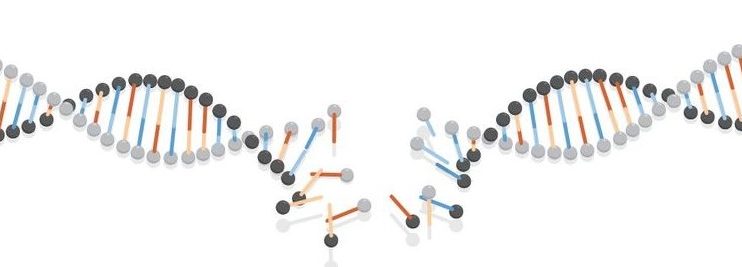“A mutation is a change or alteration that occurs in a DNA, gene, or chromosome by intrinsic or extrinsic factors such as an error in replication or exposure to UV light, respectively.”
Download this article as an ebook: Genetic Mutations pdf.
Put simply, any change that appears in a DNA or chromosome, either structurally, functionally or numerically is a mutation.
Life on earth has a basic unit, a ‘cell’- a microscopic structure present in every organism. Interestingly, a cell has an even tinier nucleus in the center which possesses an organic material known as nucleic acid- DNA or RNA.
If we are talking about the majority of organisms on earth, then they have prominently DNA as their genetic material made up of a long chain of nucleotides. The monomer unit of a long chain is technically referred to as ‘nucleotide’ and is made up of sugar, phosphate and nitrogenous bases.
The four most common nitrogenous bases in DNA are Adenine, Cytosine, Guanine and Thymine. If you wish to learn more on this topic, you can read our previous article: DNA: definition, structure, function and Types.
Now moving ahead, the function piece of the DNA, what we call a gene, crafts a protein and that is the main function of DNA. Nucleotides in a gene are arranged in a specific manner and remain the same every time. In fact, the entire genome is made up of various specific nucleotide sequences with definite length, numbers of nucleotides and arrangement.
If anything changes it leads to mutation which eventually alters the phenotype produced by a gene. Moreover, a mutation also alters the expression of a gene as well. So what exactly is the ‘mutation’? How does it occur and what are its types? All these questions I will try to answer in the present article.
In addition, I will also explain every type of mutation pictorially as well as theoretically. The present article will enhance your knowledge of genetics, greatly.
Stay tuned.
Key Topics:
What is a mutation?
“Change in the nucleotide sequence of the DNA”, is a mutation.
The mutation is a significantly important biological phenomenon in nature. Although, it has majorly remained catastrophic for life, at the same time, is advantageous too, sometimes. Studies explain that mutation indeed occurs to produce variation in nature which in the course of time, helps organisms to survive.
For instance, nature produces new alleles for our adjustments like the sickle allele for Africans while the same change causes genetic disorders like blood anemia in others when the same allele is present in a pair.
The example of sickle cell anemia is quite interesting, as it is helpful but also harmful too. We will explain it in the last part of this article, so stay tuned with the article till the end.
Let’s move ahead.
The word mutation was similar to the French word “mutacioun” which literally means “process of changing.” However, the “mutation” world was originally derived from the Latin word “mutare” which means “to change.”
The term “mutation” was coined by Hugo De Vries in 1890 but was not the pioneer in reporting mutations. Before him, an English farmer noticed mutation for the first time in his unusual short-leg male lambs during 1791. Unfortunately, he failed to define the process.
After the findings of Hugo De Vries, the mechanism of mutation was studied by Morgan in 1910. In 1927, H. J. Muller performed experiments of artificial mutagenesis. Using the X-rays he had introduced mutation in Drosophila, the first time in the history of genetics.
For his outstanding findings, he was awarded the Nobel prize in 1946.
What is mutagenesis?
“Artificial mutagenesis or site-directed mutagenesis is a process of introducing mutations into organisms artificially, for our use.” Read our article on it: Site-Directed Mutagenesis: Methods and Applications.
Definition of mutation:
“By the replication errors, exposure to mutagens and viral infections change or alteration occurs in a DNA sequence that causes genetic abnormalities, known as mutation.”
Gene mutations and chromosomal mutations are two broad categories in which the mutation is classified. We will understand each type one by one.
Gene mutation:
Gene mutation is when any change occurs in the protein-coding sequence (in a gene) which ultimately affects the function governed by that specific protein, known as gene mutation.
Type of Gene mutations:
Point mutation– Point mutation occurs at a specific point in a sequence which is usually a single base change, often known as single nucleotide polymorphism. Read our amazing article on Point mutation.
Insertion– Insertion is defined as the addition of a nucleotide in a DNA sequence, often known as addition mutation too. The addition of even a single nucleotide will change the entire reading frame and a triplet codon message using which a protein is tailored.
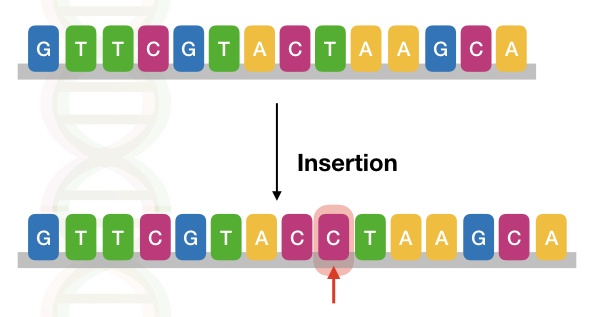
Deletion– Deletion is defined as when at least one or more nucleotides are removed from a gene sequence. As aforementioned in insertion mutation, deletion also alters the open reading frame or triplet codon of a gene.
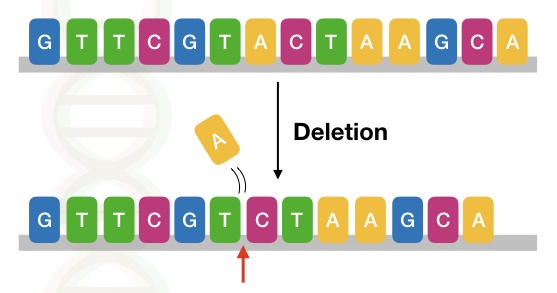
Inversion– When a gene sequence inverts and inserts back into the original sequence, it is known as inversion mutation.

Substitution– Substitution occurs when other nucleotides (one or more) replace the nucleotides of a gene. Sometimes, substitution may add a new codon to the gene.
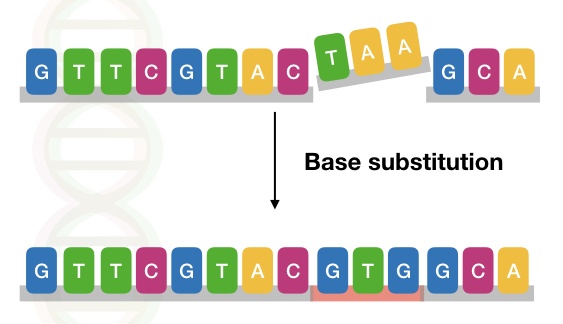
Duplication– The mutation is known as duplication when some nucleotides or a single nucleotide are duplicated or copied in a gene sequence.
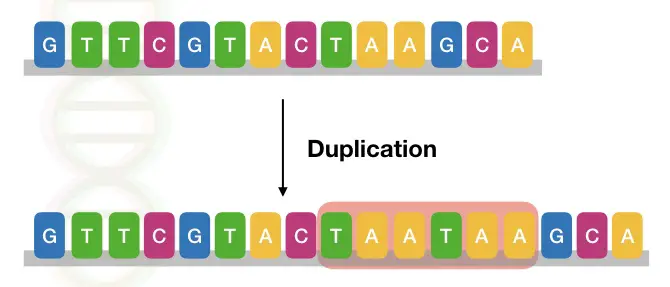
These are some of the common gene mutations, however, there are other types of mutations as well. Let us quickly go through some other known gene mutations.
Other types of gene mutations:
Forward mutation:
Genetic Mutation from wild-type to mutant or evolution of new mutation from wild-type allele is known as a forward mutation. The forward mutation leads to the evolution of new traits in the population.
Backward mutation:
Since mutation is a unidirectional phenomenon, some mutation gives the original (wild-type) allele back to the population, such mutation is known as a backward or back mutation.
A true back mutation that gives the original phenotype back in nature is very rare and unusual in nature. Conceptually, the true back mutation occurs at the same location as it occurred previously (as a forward mutation). Put simply, it gives the original/wild-type allele or codon back to the population.
Sometimes the secondary mutation also gives the same results but in different ways. When a secondary mutation occurs, at any place in a sequence, and it restores the previous/original phenotype, it is also considered as a backward mutation.
In another scenario, a secondary mutation suppresses the effect of the previous mutation thereby restoring the original function.
Copying error:
Copying error is ‘the most common intrinsic factor to produce mutation. During replication, a synthesis error incorporates a wrong base to the sequence and if remains unrepaired, such mutation is known as copying error mutation.
It abrupts the actual genetic code as a consequence, but in the majority of cases, repaired by the proof-reading activity of DNA polymerase.
Silent mutation:
A silent mutation is when a mutation leads to changing the triplet codon but codes for the same amino acid as the wild-type one, such mutation is known as silent mutation. We can say, it is a type of non-expressive one that doesn’t have any significant effect on the phenotype.
Mis-sense mutation:
The missense mutation is defined as an origin of a new codon by a mutation that makes the wrong amino acid for the protein. Resultantly, a wrong, truncated or partially functional protein is formed.
Nonsense mutation:
The nonsense mutation is defined as the addition of a stop codon to the gene or DNA sequence thereupon stops protein translation. The stop codon, in a translation, gives the signal to terminate protein synthesis. The resulting protein by nonsense mutation is a premature or truncated protein product.
Frameshift mutation:
A definite reading frame has three elements viz start codon, stop codon and in-between coding sequence. In the frameshift mutation, the entire reading frame is shifted from one to another location by a base-pairing alteration.
Henceforth, it actually changes the position of the start and stop codon. See the image,
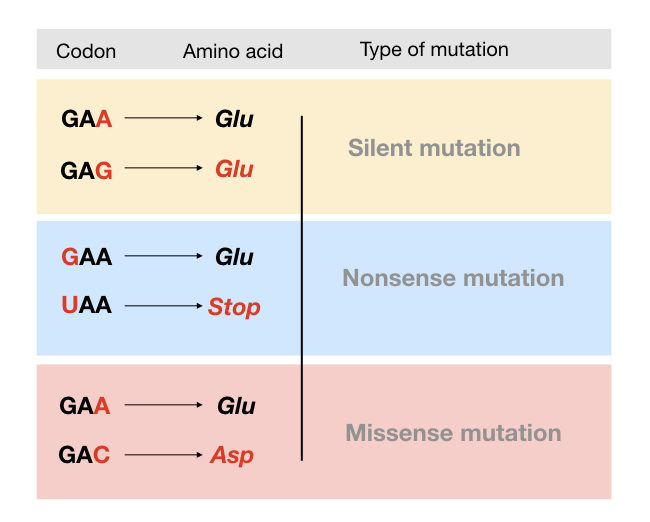
Besides these major types of mutations, other uncommon mutations are also prevalent in nature. For example, fragile X syndrome is an abnormal expansion of the triplet codon on the X chromosome. Such mutations are too large.
In another example of Duchenne Muscular Dystrophy, the entire exon gets deleted from the DMD gene. This affects the function of governing protein, directly.
Some mutations, when occurred in one gene, affect the function of another gene. For example, the SOX9 gene mutations directly change the expression of the SRY gene.
Some mutations are stable and inherited from generation to generation while some are non-stable, occurring only once in a single generation. Stable mutations are usually congenital in nature, whilst non-stable mutations occur after birth, for example, lung cancer.
It is also important to note that a stable mutation, once incorporated into the genome, can never be repaired, however, the unstable mutation can be repaired by gene therapies and is powerful enough to give the wild-type allele back.
Chromosomal mutation:
Chromosomal mutations are yet another class of mutations, commonly found in the genome. These are large and sometimes observable mutations and can vary many phenotypes. In Definition, Change or alteration into the structure or number of chromosomes is known as chromosomal mutation.
Two broad categories of chromosomal mutations are structural chromosomal mutations and numerical chromosomal mutations. Before discussing each, let us see some common chromosomal mutations.
Insertion– When a large or small chromosomal section is inserted on the chromosome arm.
Deletion– when a section of a chromosome is removed or deleted from the chromosome.

Duplication– When a section or arm of the chromosome is duplicated.
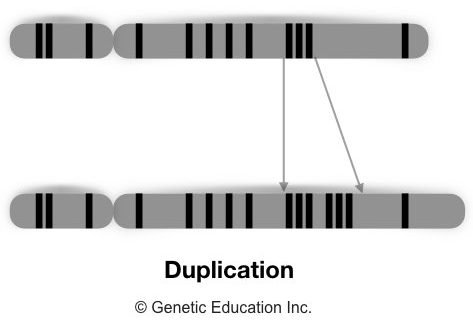
Translocation– when a section or a part of the arm, or some portion of chromosome translocated to another chromosome, is known as translocation. Three major types of translocation are balanced translation, unbalanced translocation and Robertsonian translocation.
Balanced translocation: when two segments (nearly same) are exchanged. Here, roughly or exactly both the fragments involved in the translocation process are similar in size, hence, difficult to investigate by cytogenetic analysis.
Specialized molecular cytogenetic techniques like FISH or microarray have been used to determine balanced chromosomal translocations. If you wish to learn about each technique, this article will help you. Read more on Cytogenetics: A Brief Introduction To Cytogenetics [Karyotyping, FISH and Microarray].
Studies suggest that balanced translocations are majorly involved in recurrent abortions in females.

Reciprocal translocation: Reciprocal translocation is defined as the translocation between two non-homologous chromosomes. Such mutations are common in nature.
Robertsonian translocation: Robertsonian translocation occurs between two acrocentric chromosomes. Acrocentric chromosomes are small-short chromosomes with one long q-arm and a short or very smaller p-arm.
In humans 13, 14, 15, 21, 22 and Y chromosomes are acrocentric. When translocation between two acrocentric chromosomes happens, one (nearly) metacentric and one “only centromeric” chromosome are formed.
Here long arms of both chromosomes are fused together. Therefore, one chromosome becomes a larger metacentric and another chromosome remains without any arms or only with centromere.
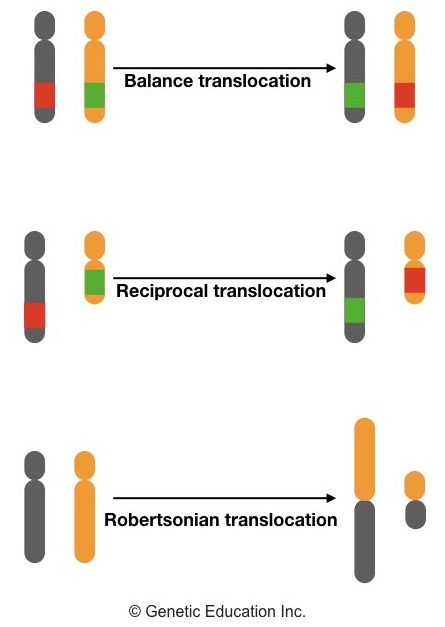
Though the “only centromeric” chromosome does not have any arm, still it contains many genes of both chromosomes. Robertsonian translocations are very rare, only reported in some cases of recurrent abortions.
Several mental retardations, trisomies and structural abnormalities are also caused by Imbalanced Robertsonian translocation.
Inversion– When a section of a chromosome is inverted and inserted back on the chromosome. If inversion occurs only on one arm, such inversions are known as paracentric inversion. The centromere isn’t involved here. If the inversion occurs between two arms of a chromosome, such inversions are known as pericentric inversion. It involves centromere in inversion.

Ring chromosome: when both ends of a chromosome are fused together, it creates a ring-like structure and so-called ring chromosome. Long metacentric chromosomes are more prone to ‘ring’ when lost the ‘sealing’ telomeric sequences.
Telomeres are specific end-regions on chromosomes that prevent end joining for chromosomes.
Ring chromosome, however, is very uncommon but shows abnormalities like microcephaly, mental retardation and epilepsy.
Aneuploidy– When the chromosome number changes and results in abnormalities, such mutations are categorized broadly into Aneuploidy. For example, trisomy is a type of aneuploidy with three chromosomes instead of a pair.
Aneuploidy is a huge topic, we will discuss various types of it in some other article.
How do mutations occur?
There are numerous agents, processes and factors that induce natural mutagenesis. Some factors are intrinsic while others are extrinsic. Replication errors and DNA repair errors are a couple of intrinsic factors whilst UV-rays and X-rays are extrinsic factors that produce mutation.
Radiations, chemicals, base analogous, teratogens, carcinogens, temperature and adverse environment are several other external factors that also frequently cause mutations.
Error in Replication:
Error in replication, as aforementioned, is the common and frequently cause mutations. When DNA polymerase reaches the end, or during the synthesis process, ends the replication process or adds a wrong base to the sequence.
When it settles in the genome, it replaces the whole genetic code from the sequence. Evidently, most of the replication errors are repaired.
Error in DNA repair
Two types of common DNA repair mechanisms a cell has are non-homologous end joining and DNA direct repair. Put simply, sometimes the repair mechanisms skip repair accidentally which causes mutation.
This topic, “how mutation occurs” is also a huge one, we will discuss it later in another article.
Mutagens:
Agents that cause mutations are known as mutagens. For example, UV rays, base analogues, and chemicals. Broadly, mutagens interfere with the base-pairing or nucleotide structure and result in mutation.
We have covered an amazing article on the mechanism of how different mutagens cause an alteration in the DNA sequence. You can read it here: Mutagens: definition, types, and mechanism.
Different types of Genetic Mutations:
Spontaneous vs Induced mutation
Spontaneous mutations originate without any known reasons, meaning, occur randomly. Metabolic, replication, cell cycle and developmental errors commonly produce random mutations.
Evidently, large genes have more chances for spontaneous mutagenesis as having higher chances of end replication errors. The rate of spontaneous mutation is 10-5 per gene per generation during replication. Note that it occurred by birth too.

On the other side,
An induced mutation is resulting from exposure of an organism to mutagenic agents. We already have mentioned some mutagens, somewhere in the article, nonetheless, commonly are chemicals and radiations.
Particularly talking about the UV light, which is the most studied mutagen, upon exposure, penetrates the skin and disrupts cell division. Though the lower energy state of the UV-light makes it unable to penetrate other tissues but only skin.
Xeroderma pigmentation and skin cancer are two examples of UV-induced mutations.
Chemicals such as alkylating agents and base analogs are common chemical mutagens. However, every chemical is somehow mutagenic to our DNA. Furthermore, climate change and lifestyle play a major role in acquiring mutations too.
Spontaneous mutations are stable, inherited and occur infrequently in populations whose rate of transmission relies on the inheritance pattern of the mutation.
Some spontaneous mutations remain recessive in parental organisms but show off symptoms when spread into the population and find another mutant allele. Its effects show in offspring. On the other side, induced mutations immediately show off their effects and consequences.
Somatic vs germ-line mutation:
Somatic mutations occur in the somatic cells only.
It doesn’t follow any specific pattern of inheritance, still, it is lethal. Notably, Only germ cells can undergo fertilization therefore those mutations which are present in germ cells can only be inherited.
Somatic mutation is restricted to some tissue or bodily organs.
But if it occurs in progenitor cells it can be spread to other daughter cells. Progenitor cells are the group of cells that have the capacity to divide further. Commonly somatic mutations cause cancer, in most cases.
Contrary, germline mutations are inherited and more dangerous than a somatic ones.
Mutations occur in egg or sperm (germ cells), it’s known as germline mutations.
In somatic mutation, if the mutation occurs in cells after metaphase, it can not be spread to the other cells. The somatic mutation occurs during mitosis whereas germline mutation occurred during meiosis.
Germline mutations may or may not affect the parental organism but they will surely affect the offspring. Also, the germline mutations are generally non-curable.
All the disorders which follow the Mendelian pattern of inheritance are germline mutations.

Actually, the germline mutations help in evolution by providing new alleles, yet, it may harmful too.
On the other hand, somatic mutations affect only the organism having the mutation. It doesn’t have any role in evolution.
Somatic mutations are restricted to an individual, if it is lethal, an individual may die but it can’t transmit to other organisms in the population.
Whereas germline mutations are silent, it remains in a recessive condition in some organisms and steadily spreads throughout the population.
Chromosomal mutation vs mitochondrial mutation:
Mitochondria are the powerhouse organelle of our cells. Mitochondrial DNA (mtDNA) is present in mitochondrial (not in the nucleus), and it has its own replication and transcription machinery.
Genomic mutations may be either syndromic or Mendelian while the mitochondrial mutations are neither syndromic nor Mendelian.
Because it is inherited from the maternal organism only, it is known as maternally inherited DNA. Thus, if any mutation is induced in the mtDNA and is inherited to male offspring, it can’t further be transmitted.
On the other side,
Chromosomal DNA is inherited from both parents. notably, not all chromosomal mutations are inherited in Mendelian fashion.
For instance, Cri du chat syndrome, Down syndrome, and Patau syndrome are some of the common types of chromosomal disorders that do not follow Mendelian inheritance.
Mitochondrial DNA is inherited maternally, it is rarest among rare.
Kearns- syre syndrome, Leigh syndrome and non-syndromic hearing loss are some of the mitochondrial disorders which arise due to the mutation in mtDNA.
Deletion, duplication, translocation and inversion are some of the common types of mutations observed in mtDNA, same as genomic DNA.
Morphological mutation:
The Genetic mutation which affects the outer characteristic or physical characteristic or phenotype of an organism is called a morphological mutation.
This type of mutation alters the physical properties like the shape, size, and color of an organism.

Lethal mutation:
A Genetic mutation that causes the death of an organism or affects the survival of an organism is called a lethal mutation.
If a mutation causes death in a certain environment then the mutation is known as a conditional lethal mutation.
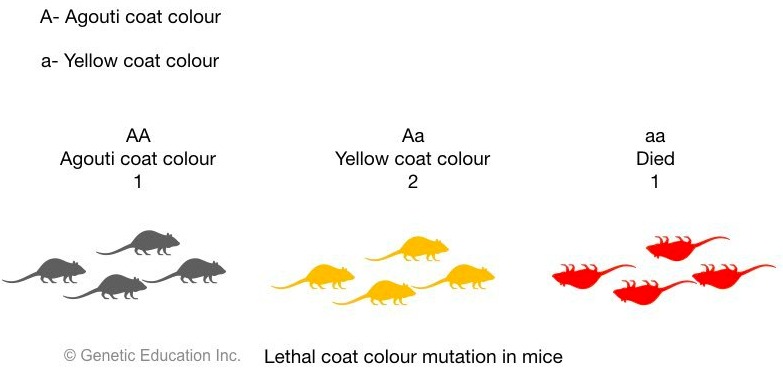
Conditional mutation:
In this type of genetic mutation, the mutant allele causes mutant phenotype in a certain specific environment or conditions and remains wild type in some other environment.
Let’s take the example of bacteria,
The conditions which favor the growth of mutant colonies are called restrictive conditions.
In contrast, conditions that cause the growth of wild-type phenotype (having wild-type allele) are called permissive conditions.
In this experiment, if some special type of essential amino acid is given into the culture medium, then and then, the mutant bacteria will grow otherwise in the lack of it, only wild-type bacteria can grow.
See the figure,

Conditional mutation is very important in genetic studies. We can study the characteristics of an allele, and how it behaves in different adverse conditions. We can estimate the time duration of gene action as well.
Biochemical mutation:
Each cell required energy and nutrients for differentiation and survival. Different biochemical pathway inside the cell provides that essential requirement.
For mutation studies, bacteria are the most suitable model organism because of their unique properties.
Bacteria or microbial cultures which can grow on minimal media (only simple inorganic salts) are called prototrophic.
In contrast, the mutant bacterial culture which requires all the essential nutrients like amino acids and other organic salts is called auxotrophic.
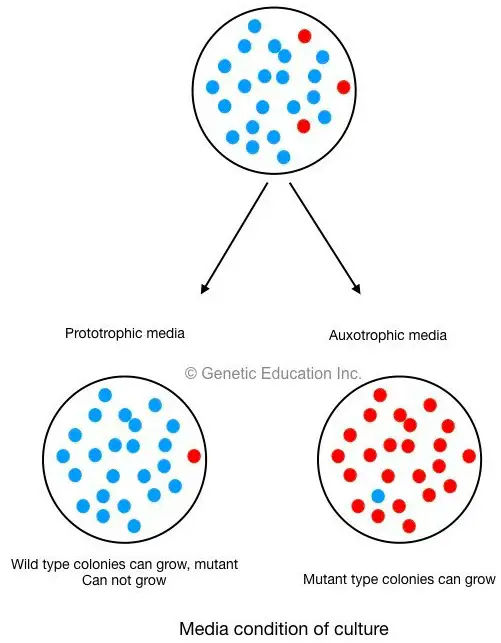
Wild-type cultures are prototrophic while biochemical mutants are auxotrophic in nature because biochemical mutant doesn’t have some metabolites which they require to grow.
Hence they need all types of nutrients.
Auxotrophic mutants are unable to synthesize essential nutrients like amino acids, vitamins and nitrogenous bases whereas wild-type strains of bacteria can synthesize all the essential metabolites.
When nutrients and metabolites-rich media are given to auxotrophic mutants, the condition has become permissive for them and mutant colonies can grow faster.
Loss of function mutation:
In simple terms, a mutation that causes functional loss of the gene is called a loss of function mutation. Loss of function mutation depends on the condition of inheritance of that mutation. Generally, it remains recessive.
If the wild-type normal allele is dominant and expressed over the mutant allele then even in heterozygous condition, the loss of function mutation remains recessive. It is also called a null mutation.
Mutant allele is expressed in a condition where both the recessive alleles (homozygous recessive) are overexpressed as compared to the normal wild-type allele.
Gain of function mutation:
Loss of function Genetic mutations are most common in nature, but some mutation gives a new function to the gene or give the original function back to the gene. This type of mutation is a gain of function mutation.
However, these types of mutations are rare. Remember, sickle allele.
In sickle cell anemia-heterozygous condition, individuals remain unaffected but mutation gives one additional benefit. It protects against the malaria parasite. Despite this, in the homozygous mutant condition, it causes anemia.
Temperature-sensitive mutant:
Mutant that is growing at one temperature and remains suppressed at another temperature, is called a temperature-sensitive mutation.
Most enzyme-coding genes are temperature sensitive because enzymes are activated at a once specific temperature.
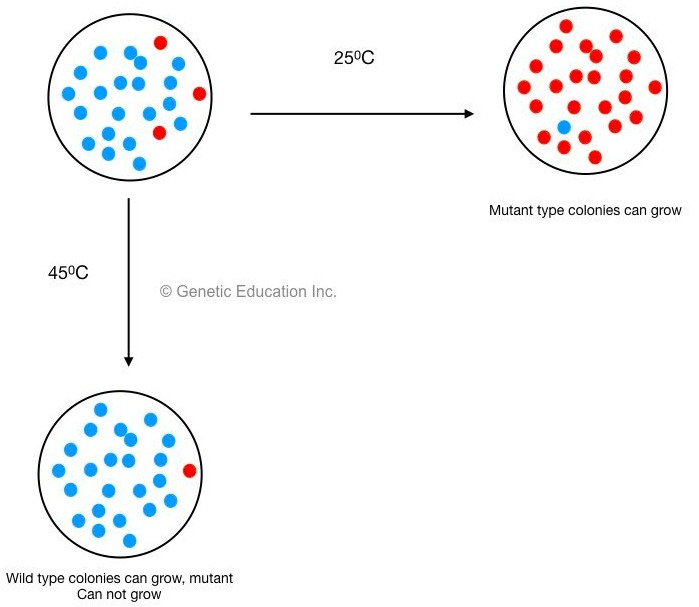
Examples of genetic mutations:
Here in the last segment of this article, I am enlisting some of the examples of genes and other mutations in tabular form.
| Type of mutation | Example | Description |
| Deletion (Point mutation) | Cystic fibrosis | A single gene, autosomal recessive condition. |
| Base substitution | Sickle cell anemia | Read the article for more detail. (link) |
| Insertion | Beta thalassemia | A single gene, autosomal recessive condition. |
| Chromosomal deletion | Cri-do-chat | Deletion on the p arm of chromosome 5. |
| Chromosomal translocation | Philadelphia chromosome | Translocation between 4 and 17. |
| Chromosomal duplication | A type of cancer | Some amount of chromosomes duplicated. |
| Trisomy 21 | Down syndrome | An extra copy of chromosome 21. |
| Frameshift mutation | Crohn’s disease | Insertion of a premature stop codon. |
Are mutations helpful?
Not always but not harmful always, even.
Any alteration in nature occurs to make us survive on earth. New alleles originate due to changes in the sequence of a gene. Which probably happens in our favor.
Now coming to our question regarding sickle cell anemia. SCD is a type of autosomal recessive genetic condition. This means a single allele isn’t enough to cause disease.
The sickle allele (HbS) is, in fact, originated to make us survive against malaria. In the case of sickle cells, RBCs become sickle cells, instead of the normal doughnut shape. Hence the malaria parasite can’t identify it.
It is an evolutionary gift for us, especially, in the African subcontinent where malaria is more prevalent.
On the other side, some random mutations can cause cancer like a lethal condition.
Thus, we can say, “mutations are helpful but not always or mutations are harmful but not always.”
Perhaps what I think, is random cancer-causing mutations are lethal because it helps to spread the mutant harmful allele in the population. In this context also, the mutations are helpful.
Besides, using the artificial mutagenesis techniques, any new mutations can be introduced into the DNA sequence of our interest.
By this, we can create new genetically modified organisms for some experimental purposes.
Pleiotropy:
Pleiotropy is the mechanism in which the mutation in one gene influences more than one trait or phenotype.
Again recall the situation in sickle cell anemia. Mutant HBS allele results in anemic condition as well as protect the heterozygous individual from the malaria parasite. We will discuss pleiotropy broadly in other articles.
Conclusion:
Different types of Genetic mutations randomly occur in the population.
It creates allelic variation in a genome and the new allele originates in the population.
Polymorphism is a natural phenomenon. A genetic mutation occurs to make us adaptive in any adverse environment but it may be harmful sometimes. Scientifically we can say, “what we are today, is a result of millions of mutations in the past”.
Source
Griffiths AJF, Gelbart WM, Miller JH, et al. Modern Genetic Analysis. New York: W. H. Freeman; 1999. The Molecular Basis of Mutation.

